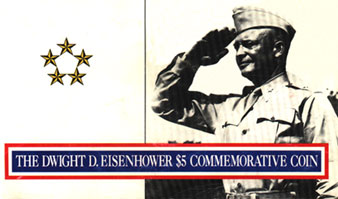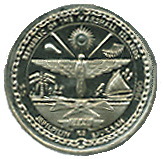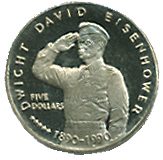
The Second World War truly became a war on a global scale when the United States hurled its military might into the conflict in December 1941. Though a key element to the eventual Allied victory, many problems faced the fight for freedom. Not the least of these was choosing a single leader to direct the campaign on the European Theatre. To lead with any degree of success would take a firm, yet careful hand. One man had these qualities: Dwight D. Eisenhower, named Supreme Commander of the Allied Forces on January 16, 1944, was a steady hand in a dire situation. Had any other man been chosen, the outcome of the war might have been different. Quiet, calm and certain, Eisenhower led a group of egotistical and sometimes hardheaded subordinates with brilliance. He urged complete cooperation among Allied officers and troops, vowing to ship home anyone who didn't comply on a "slow boat" without an escort. Thus he honed the concept of "coalition warfare" to a fine edge. Though some of his decisions were controversial, he stuck to them under a barrage of criticism. Because of this, he gained respect among his peers and world leaders as the man who gave freedom the final victory.
Eisenhower's most brilliant maneuver came on June 6, 1944, with the Allied invasion in Normandy, D-Day. With all the brilliance and innovation of a master chess player, Eisenhower directed the invasion. Boldly, Ike ordered the attack to begin on June 6 after a twenty-four hour delay due to bad weather in the English Channel. The order was a gamble, based on a possible break in the weather, but it worked. The entrenched Germans were taken by surprise when the first of the troops swarmed the beach at 6:31 a.m. The success of the Allied thrust was a major coup for Ike in his rise to fame. Within days, the beachheads were linked in one united front and the beginning of Hitler's demise was at hand. Then - again under Ike's bold command - the troops sliced through France, crossing the Rhine River into Germany just seven months later, emerging victorious on May 7, 1945.

The Dwight D. Eisenhower $5 Commemorative Coin was issued by the Republic of the Marshall Islands in 1990 to commemorate the 100th anniversary of Eisenhower's birth on October 14, 1890. This cupronickel coin is legal tender of the Marshall Islands, which was one of the key battlegrounds in the Allies' march across the Pacific during World War II. The obverse of the coin bears a commending portrait of Eisenhower in his role as a 5-star General, and reflects his strong leadership and firm commitment to the cause of freedom. The design was created by the internationally acclaimed sculptor and coin designer, Mico Kaufman, who has also created numerous award-winning medals and is known for his precision and attention to detail. On the reverse of the coin is the national seal of the Marshall Islands which appears on all its coinage. The motto, "Jepilpilin Ke Ejukaan," means "Accomplishment Through Joint Effort," and the design centers on the nation's symbol, the Spirit Bird of Peace. The Marshall Islands became independent in 1986.
 |
  |